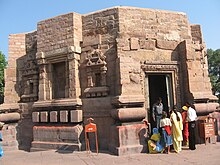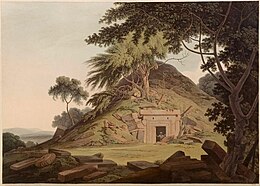

| Mundeshwari Temple | |
|---|---|

Nagara style architecture of the temple.
| |
| Religion | |
| Affiliation | Hinduism |
| District | Kaimur district |
| Deity | Shiva and Shakthi |
| Festivals | Ramnavami, Shivratri, Navaratra. |
| Location | |
| Location | Paunra Pahad, Ramgarh village |
| State | Bihar |
| Country | India |
|
Show map of India
Mundeshwari Temple (Bihar) Show map of Bihar | |
| Geographic coordinates | 24°59′00″N 83°33′53″E / 24.9833958°N 83.5646939°E / 24.9833958; 83.5646939 |
| Architecture | |
| Completed | 635 CE[1] Hindu inscriptions dated 4th century AD were found in the temple m.[citation needed] |
| Specifications | |
| Temple(s) | One |
| Elevation | 608 m (1,995 ft) |
The Mundeshwari Devi Temple (also spelled Mundesvari) is a Hindu temple, located at Ramgarh Village, 608 feet (185 m)[2] on the Mundeshwari Hills of Kaimur plateau near Son River, in the Indian stateofBihar. It is an Archaeological Survey of India (ASI) protected monument since 1915.[3] The ASI has dated the structure to 108 CE making it the oldest Hindu temple in Northern India.[4][5][6]
It is an ancient temple which is believed to be dedicated to the worship of the goddess Durga and god Shiva is considered as the oldest functional Hindu temple of the World.[7][8][9] The findings also established that here was a religious and educational center spread over the hillock and Mandaleshwar (Shiva) temple was the main shrine. The Mandaleshwari (Durga) was on the southern side. The temple was damaged and the idol of Mandaleshwari (degenerated Mundeshwari and later connected with the mythical demon Mund) was kept in the eastern chamber of the main temple.[10]


The worship of Devi Durga in the form of Devi Mundeshwari in the temple is also indicative of tantric cult of worship, which is practiced in Eastern India.[7]
Rituals and worship have been performed here without a break, hence Mundeshwari is considered one of the most ancient Hindu temples in India. The temple is visited by a large number of pilgrims each year, particularly during the Ramnavami, Shivratri festivals.[7] A big annual fair (mela) is held nearby during the Navaratra visited by thousands.[11]
The temple, built of stone, is on an octagonal plan, which is rare. It is the earliest specimen of the Nagara style of temple architecture in Bihar. There are doors or windows on four sides and small niches for the reception of statues in the remaining four walls.[12] The temple shikhara or tower has been destroyed. However, a roof has been built, as part of renovation work. The interior walls have niches and bold mouldings which are carved with vase and foliage designs. At the entrance to the temple, the door jambs are seen with carved images of Dvarapalas, Ganga, Yamuna and many other murtis. The main deities in the sanctum sanctorum of the temple are of the Devi Mundeshwari and Chaturmukh (four-faced) Shiva linga. There are also two stone vessels of unusual design.[13] Even though the Shiva linga is installed in the centre of the sanctum, the main presiding deity is Devi Mundeshwari deified inside a niche, which is seen with ten hands holding symbols riding a buffalo, attributed to Mahishasuramardini.[14] The temple also has murtis of other popular gods such as Ganesha, Surya and Vishnu. A substantial part of this stone structure has been damaged, and many stone fragments are seen strewn around the temple. However, under the jurisdiction of ASI, it has been the subject of archaeological study for quite some time.[3][7][15][16]
The Archaeological Survey of India has restored the temple under instruction from the Union Ministry of Culture. Restorative works included the removal of soot from the temple interior via a chemical treatment, repair of damage to religious murti (idol) and cataloging and documentation of scattered fragments for later reuse. Other works included installation of solar powered lighting, displays for antiquities and provision of public amenities. The Government of Bihar has allocated Rs 2 crore to improve access to the temple.[17][16]
It can be reached by road via Patna, Gaya, or Varanasi. The nearest railway station is at Mohania - Bhabua Road railway station from where the temple is 22 km by road.[15] Lal Bahadur Shastri International Airport, Varanasi is the nearest airport, located at a distance of 102 km from the Temple. Indian carriers including Air India, Spicejet, and international carriers like Air India, Thai Airways International, Korean Air and Naaz Airlines operate from here. Daily flights to Delhi, Mumbai and Kolkata are available from here.
Changu Narayan Temple, in Kathmandu, Nepal
The pagoda style temple has several masterpieces of 5th and 12th century Nepalese art. According to legends Changu Narayan temple existed as early as 325 A.D. in the time of Licchavi King Hari Datta Verma and it is one of Nepal’s richest structures historically as well as artistically. In the grounds there is a stone pillar inscription of great importance recording the military exploits of King Man Deva who reigned from 496 A.D. to 524 A.D. The first epigraphic evidence of Nepalese history found in the temple premises during the reign of the Licchavi King Mandeva dating back to 464 A.D. shows that Changu had already been established as a sacred site in the 3rd century A.D. It is the earliest inscription known in Nepal. The temple was restored during the lifetime of Ganga Rani, consort of Siva Simha Malla who reigned from 1585 to 1614.
Mundeshwari Devi Temple in Bihar, India
Mundeshwari Devi Temple in Bihar, India, dedicated to the worship of Lord Shiva and Shakti. The inscription of an information plaque erected by the Archaeological Survey of India (ASI) at the site indicates the dating of the temple to 635 AD. However, there are other versions for the dating stating the Saka era, prior to Gupta dynasty rule (320 AD) in India, and specifically to 105 AD according to the Administrator of the Bihar Religious Trust Board